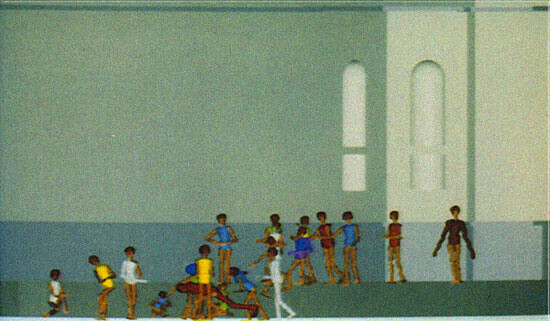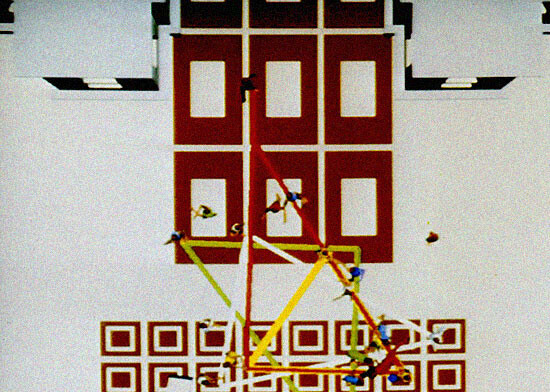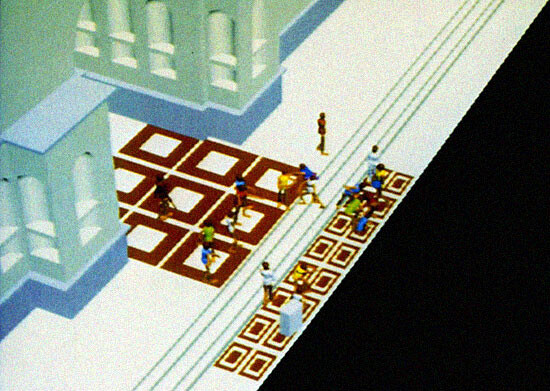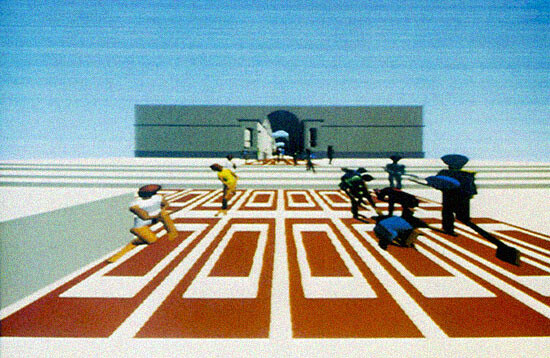The central thesis of this text is that philosophy is, at its deepest level, a program—a collection of action-principles and practices-or-operations which involve realizabilities, i.e., what can be possibly brought about by a specific category of properties or forms. And that to properly define philosophy and to highlight its significance, we should approach philosophy by first examining its programmatic nature. This means that rather than starting the inquiry into the nature of philosophy by asking “what is philosophy trying to say, what does it really mean, what is its application, does it have any relevance?,” we should ask “what sort of program is philosophy, how does it function, what are its operational effects, realizabilities specific to which forms does it elaborate, and finally, as a program, what kinds of experimentation does it involve?”
Even though the corollary problems of philosophy as a specialized discipline (the tenor of its discourses, its traction beyond its own domain, its applications and referential imports) can in no way be ignored, they are however problems that, as it will be argued, can only be sufficiently addressed in the context of philosophy as deeper cognitive enterprise. The primary focus of this cognitive program is to methodically urge thought to identify and bring about realizabilities afforded by its properties (theoretical and practical intelligibilities pertaining to thinking as such), to explore what can possibly come out of thinking and what thought can become.


§1. Traditionally, philosophy is an ascetic program for the craft of (general) intelligence.
Ascetic to the extent that philosophy involves the exercise of a multistage, disciplined, and open-ended reflection on the condition of the possibility of itself as a form of thought that turns thinking into a program. The real import of this definition resides in precisely what a program consists in. Accordingly, in order to elucidate the significance of philosophy both as a programmatic discipline and as a form of thought that transforms thinking into a programmatic project, first we should elaborate what is meant by “program” in its most generic sense. To do so, the notion of program—in the sense of action-principles and practices-or-operations that bring about something—should be defined parsimoniously in terms of its bare formal armature, stripped to those generic yet necessary features that underlie any type of program regardless of its applications or aims. These are: the selection of a set of axioms, and the elaboration of what follows from this choice if the axioms were treated not as immutable postulates but as abstract modules that can act upon one another.
A program is the embodiment of the inter-actions between its set of axioms that reflect a range of dynamic behaviors with their own complexity and distinct properties. More specifically, it can be said that programs are constructions that extract operational content from their axioms and develop different possibilities of realization (what can be brought about) from this operational content. And respectively, axioms are operational objects or abstract realizers that encapsulate information regarding their specific properties or categories. In this sense, programs elaborate realizabilities (what can possibly be realized or brought about) from a set of elementary abstract realizers (what has operational information concerning the realization or the bringing-about of a specific category of properties and behaviors) in more complex setups.
In the programmatic framework, the choice of axioms does not confine the program to the explicit terms of axioms. Rather, it commits the program to their underlying properties and operations specific to their class of complexity. To put it differently, a program constructs possible realizabilities for the underlying properties of its axioms, it is not essentially restricted to their terms. A conveniently intuitive albeit imprecise and rudimentary example of this would be:
1. a is an E
In a Platonic style this can be roughly translated to: “If the form (E) Socrates partially exhibits defines who Socrates is (a),” or in a more straightforward way, “if Socrates is a rational life-form.”
2. a does x = F for function or activity
“Then Socrates does something that displays particular properties of that realm of form,” or “then Socrates does x as a rational life-form.”


As a rational life-form, Socrates is a particular pattern-uniformity through which implicit patterns or properties specific to the realm of forms can be realized in the temporal order. F, or what Socrates does as a rational life-form, is a partial realization of these forms as an intelligible practice or operation. In other words, F is a practice whose operational content can be traced, changed, and combined with other practices to construct more complex realizabilities specific to the realm of forms that Socrates partially embodies. In this example, 1 and 2 represent the axiom and its basic operational information that can be abbreviated to “this a is F of E-form” (again roughly translating to “Socrates’s actions reflect the form to which he belongs,” or “Socrates is what he does as a rational life-form”).
This means that “if a has the form E, then it does x” and “the function or activity F typifies E-form.” Here, the Platonic concept of form has been used in place of a category of underlying properties. Now this can be further compacted, “the form E, at the very least, does x.” The program then elaborates the possible realizabilities of the form E. At the very least, the program can do or bring about x (the unprocessed operational content of the axiom). Or by introducing more axioms and following different strategies (or action schemas) by which operational contents of axioms can be brought to bear on one another, the program can construct other activities related to E. Following the above example, this can be expressed as:
A-1: When in S1 (a particular state of affairs that gives a context to what Socrates does), Socrates does x (x typifies a behavior related to general properties of the rational life-form).
A-2: When in S2, Confucius does y (y typifies another behavior that reflects general properties of the rational life-form).
Program: various schemas of interaction or operational intercontent between x-act and y-act as typifying a rational life-form. Depending on how interactions or the operational exchange between axioms are performed and regulated (synchronous or asynchronous), what strategies or behaviors they follow, whether the elementary interactions are nondeterministic or deterministic and so on, the program can both extract the specificities of the rational life-form (what a rational life-form really is and consists in) and bring about its possible realizabilities (what a rational life-form can possibly do). These realizabilities are constructed Fs that are not essentially entailed by the explicit terms of the axioms.
By plugging axioms and their operational contents together, the program also binds their respective states of affairs (S). The system of one axiom (the information regarding what it does and the state or the situation where this activity or behavior takes place) becomes the environment of the other axiom and vice versa. In this sense, the exchange between axioms can be seen as an ongoing communication between abstract agents which acquire new capacities or abilities as they respond to one another, in a manner which is similar to how multiagent systems dynamically evolve. A program, for this reason, is not a loose collection of axioms on which static principles or instructions are imposed. Possible compositions of axioms—or how axioms can hang together and interact—are process unfoldings through which the program can extract additional details from the underlying properties and utilize them to search and construct possible realizabilities.
In the programmatic framework, axioms are no longer sacrosanct elements of the system eternally anchored in some absolute foundation, but acting processes that can be updated, repaired, terminated, or composed into composite acts through interaction. These composite acts exhibit complex dynamic behaviors that could not be generated if the axioms where taken in isolation or treated as fixed foundational principles. In this sense, a program executes the global effects of the confrontation between axioms as elementary acts, i.e., the interaction. These global effects are possible realizabilities of the program, or what can be brought about.
New properties and possible realizabilities can be uncovered by experimenting with the operational architecture of the program. Experimentation in a program involves both a controlled relaxation of existing constraints on how axioms hang together, how their operational contents are exchanged, as well as the addition of new constraints. It is through this form of manipulation that the range of realizabilities specific to a category of properties is broadened. For example, the relaxation or addition of constraints can lead to different modes of compositionality (how axioms and their operational content can hang together). It can suspend the so-called innocence of axioms in that each time axioms are called up they behave differently and result in different ramifications. On higher levels of experimentation, new axioms with different properties can be introduced to develop wider arrays of operations. And operations that typify other properties can be fused with existing operations to construct more complex realizabilities.
The meaning of the program is not entailed in its axioms—what they refer to or what they denote—but in how and under what conditions they interact. The right question in addressing a program is not “what do these axioms stand for or what does this program mean?,” but “what is this program, how does it act, what are its possible operational effects?”
In short, what a program articulates is the operational destinies of the underlying properties of its axioms qua acting processes. The meaning of a program is a corollary of its operations, the contexts and senses of its acts and functions. Rather than being fixed upon some preestablished semantic of utility or metaphysical reference, this meaning is not only paradigmatically actional but also attached to the operational prospects of the program itself, i.e., its possible realizabilities.
This is precisely how philosophy is approached here. Rather than by starting from corollaries (the import of its discourse as a specialized discipline, what it discusses, and so on), philosophy is approached as a special kind of a program whose meaning is dependent upon what it does and how it does it, its operational destinies and possible realizabilities. In the first part of this text (Axioms and Programs), what will be discussed is the overall scope of philosophy as a program that is deeply entangled with the functional architecture of what we call thinking. In the second part (Programs and Realizabilities), the realizabilities of this program will be elaborated in terms of the construction of a form of intelligence that represents the ultimate vocation of thought.


§2. Philosophy is a program whose primary axioms are those that pertain to the possibility of thought as such. Its basic task is to elaborate the operational content behind such possibility in terms of what can be done with thought, or more broadly, what thought can realize out of itself. If “thought is or would be possible at all” then what would be the ramifications of such possibility?
The significance of philosophy is in this simple yet vastly consequential trivia that it uses the possibility of thought as its premise, as an axiom that can be systematically acted upon. In doing so, it commits to the elaboration of what comes after the premise, i.e., what can be realized from thought and what thought can do, or more accurately, the possibility of a thought set on developing its own functional realizations.
The choice of axiom is a programmatic initiative for the reason that it opens up the prospect of constructing different realizations of properties the axioms represent. Rather than simply being a neutral assumption—or worse, an entrenched dogma—philosophy’s axiomatization of the possibility of thought is the first major step toward programming thinking as such.
Once the possibility of thought is adopted as an explicit axiom (as what must be acted upon), thinking becomes a matter of extracting and expanding the operational content implicit to the possibility of thought qua the axiom. The focus of thought’s operational activities—the acts of thinking—is turned toward elaborating the content of thought’s possibility in the sense of articulating what can be done with such possibility (program’s operational possibilities) and what thought can become by acting on its very possibility (program’s possible realizabilities). In other words, philosophy programs thought to systematically act on itself, to realize its own ends and demands, and to have as its main vocation a disciplined and persistent reflection on the prospects of its realizabilities. Thinking is no longer merely exercised as a non-optional practice but a practical enterprise.
This is where “philosophy as a program” overlaps “philosophy as a form of thought that turns thinking into a program.” In using the resources of thought to determine the scope of thought’s realizabilities, philosophy becomes thought’s program for exploring and bringing about its own realizations. Put differently, philosophy’s tacit assertion that “thought is programmable” is repurposed by thought as its principal normative task: “thought ought to be programmed.” It is through this normative task that thought explicitly posits its own ends and augments the prospects for what it can do. Philosophy, in this sense, is more than being simply one mode of thought among others. It is thought’s own cognitive-practical prosthesis for developing and augmenting a drive for self-determination and realization. A thought that has a drive for self-realization is a thought that before anything else secures its own ends. But to secure its ends, thought must issue and prioritize its own demands.
These demands first and foremost are concerned with wresting thought from heteronomous influences, be they associated with a higher authority, with the contingent conditions of its original setup, or with final or material causes. However, as these demands evolve, their focus shifts away from a resistance against the hold of heteronomy, toward an active articulation of the consequences brought about by autonomy. They change from demands of a realized thought to demands of a thought for which what is already realized—i.e., its current state or present instantiation—is not itself a sufficient expression of autonomy. This is a thought that makes its autonomy explicit by identifying and constructing its possible realizabilities. Its demands are centered on the prospects of realization of thought by different material realizers (not to be confused with the abstract realizers or axioms of the program). In other words, these demands revolve around the possibility of reconstituting thought outside of both what currently constitutes it and how it is constituted. They are the demands to reclaim and research the possibility of thought, but no longer under the limitative terms laid down by its native realizers (or constituents) or its present instantiation.
Accordingly, this reprogramming overhaul is not limited only to those material realizers or constitutive components and mechanisms that are directly at odds with thought’s autonomy. It includes also those internal constitutive features that restrict the scope of thought’s realizabilities or possible constructions. It does not matter whether such realizers are part of the biological evolution or sociocultural constitution of thought. As long as they exert heteronomous influences on the current realized state and functions of thought, or restrict the future prospects of thought’s autonomy (the scope of its possible realizabilities), they are potential targets of an extensive reprogramming.


In order for thought to maintain its autonomy—in the sense of being able to institute and adjudicate its own ends—it must adjust or replace those conditions and constituents that impinge on its current state and functions. But for thought to be able to elaborate and follow the consequences of the autonomy of its ends, to render intelligible the ramifications of its possibility, it must free itself from those terms and conditions that confine it to a particular state of realization. This systematic move toward separating the possibility of thought from the circumscriptions of a singular state of realization is the beginning of a cognitive-practical inquiry into the possible realizabilities of thought. And it is precisely by investigating and constructing possible realizabilities of thought that the consequences of thought’s autonomy and the ramifications of its possibility can be truly made intelligible.
In this sense, the inquiry into the possible realizabilities of thought is synonymous with an inquiry into the purposes of thought that are neither given in advance nor exhausted by its present instantiation. Indeed, the inquiry into the meaning and purposes of thought can only radically begin via a thoroughgoing theoretical and practical project aimed at reconstituting the possibility of thought outside of its contingently situated constitution and its current realized state. Determining what thought is, what its purposes are, and what it can do then becomes a matter of exploring and constructing different realizabilities of thought outside of its natural habitat.
Thought’s program to institute its autonomous ends leads up to a phase in which thought is compelled—via the imperative of its time-general ends—to define and investigate its purposes by recasting its current state of realization. This phase marks a new juncture in the development of thought’s autonomy for the reason that it involves the unbinding of both the realizabilities and purposes of thought. To this extent, the organized venture toward the functional realization of thought outside of its native home and designated format is in every sense a program of the decontainment of thought. It is therefore a distinctly philosophical endeavor in that it normatively enacts an enduring philosophical wager, “thought cannot be contained”: thought ought not to be contained.
What was initiated by philosophy’s seemingly innocent axiom is now a program that directs thought to theoretically and practically inquire into its futures—understood as prospects of realizability that are asymmetric to its past and present. The thrust of this program is that the scope of its operations and constructive manipulations encompass both the realizer and the realized, the constituent and the constituted, what thought is made of and what thought manifestly is. As the ultimate expression of demands of thought, this transformative program is exactly the distillation of the perennial questions of philosophy—what to think and what to do—propelled forward by an as yet largely unapprehended force called philosophy’s chronic compulsion to think.


§3. By reformatting thinking from a by-product of material and social organizations into a programmatic normative enterprise that rigorously inquires into its operational and constructive possibilities, philosophy introduces a vision of the artificial into the practice of thinking. Rather than a thought that is simply accustomed to the use of artifacts and has a concept of artificiality, this is a thought that is itself a practice of artificialization.
The concept of the artificial signifies the idea of craft as a recipe for making something whose purposes are not entailed by or given in its material ingredients even though they are afforded by their properties. These purposes should be understood not solely in terms of (external) purposes in which the product of the craft (the artifact) is used but also as potential functionalities related to possible realizabilities of the artifact itself regardless of its use or purpose of consumption. In this respect, the artificial expresses the complex and evolving interplay between external functionality (the context of use as the external purpose of the craft) and possible realizabilities of the artifact itself. This interplay can be seen as a harnessing process that couples the function as the use of the artifact with function as an instantiation of possible realizabilities of the artifact. By coupling these two categories of function, the process of artificialization produces or harnesses (in the constraining sense of “harness”) new functionalities and purposes from the positive constraints established between the use and realizabilities of the artifact.
The role of an artifact in practical reasoning is inherently double-faced to the extent that it is simultaneously determined by the established purpose and the realizabilities of the artifact itself. The structure of practical reasoning about artifacts (as in “artifact a is a means to bring about outcome c, so I ought to use a when in situation s as a means to c”) is affected by this interplay between uses and realizabilities. If we take the purpose of an artifact (the established context of use) as premises for bringing about a certain outcome, realizabilities of the artifacts can be thought as the addition of new axioms with new terms that weaken the idempotency and monotonicity of entailment in a practical reasoning. Different instances of application for a given artifact may lead to different consequences or ends (weakening of idempotency), and the addition of new assumptions regarding the use of an artifact may change the end for which an artifact is a means (weakening of monotonicity).1
Artificialization can, therefore, be defined as a process aimed at functionally repurposing and exhibiting a vastly non-inertial and non-monotonic behavior with regard to consequences or ends. This repurposing can manifest as the augmentation of the existing realization of the artifact, the abstraction and transplantation of some existing function or salient property in a different or an entirely new context of use and operation, the readaptation of an existing use to a different instantiation of an artifact’s realizabilities, and in its most radical form, the construction of both new uses and realizations by engaging in a craft that involves both a new mode of abstraction and a deeper order of intelligibilities (of materials and practices).
If what underlines the concept of artificialization is the constructive adaptation to different purposes and realizabilities, then in realizing its own ends and adapting its realization to the growing demands of such ends, thinking turns into a radical artificializing process. At its core, a thought amplified by philosophy to systematically inquire into the ramifications of its possibility—to explore its realizabilities and purposes—is thought that in the most fundamental sense is a rigorous artificializing program. This thought is at once dedicated to conceiving and adapting to new ends, and committed to a program of concrete self-artificialization. For a thought that has its own ends and demands, self-artificialization is an expression of its commitment to exploring its possible realizabilities, to reclaiming its possibility from heteronomous and limitative terms imposed by its natural realizers and native habitat. In other words, it is an expression of its commitment to the autonomy or rule of its ends.
However, in order for thinking to examine its possible realizabilities, it must first establish its inherent amenability to the process of artificialization. The first step is showing that thinking is not an ineffable thing but an activity or a function, special but not supernatural, and that it can be programmed, repurposed, and turned into an enterprise for the design of agency, in the sense that every step in the pursuit of this enterprise will have far-reaching consequences for the structure of this agency.
This is what is exemplified in its most resolute form in the earliest practices of philosophy, particularly the Cynic, Stoic, and Confucian proposals regarding the programmatic aspects of thinking: to understand thinking itself as an administrative function, to not isolate thinking from living but to treat life as a craft of thinking, rather than disposing of emotions and affects, giving them structure by bringing them in line with the ends of thought, and to demonstrate in every step of life the possibilities of thinking as a purpose-conferring and repurposable activity. Succinctly put, the common thesis underlying these programmatic philosophical practices is that in treating thought as the artifact of its own ends, one becomes the artifact of thought’s artificial realizabilities.2
This is one of the most potent achievements of philosophy: by formulating the concept of a good life in terms of a practical possibility afforded by the artificial manipulability of thinking as a constructible and repurposable activity, it draws a link between the possibility of realizing thought in the artifact and the pursuit of the good. The idea of the realization of thinking in artifacts can be presented as an expression of thought’s demand to expand its realizabilities. And therefore, it can be framed in the context of crafting a life that would satisfy a thought that demands the development of its possible realizabilities in whatever form or configuration possible—that is, a thought whose genuine intelligibility is in the exploration of what it can be and what it can do.
The craft of an intelligent life-form that has at the very least all the capacities of the present thinking subject is an extension of the craft of a good life as a life suiting the subject of a thought that has expanded its inquiry into the intelligibility of the sources and consequences of its realization. Put it in another way, it is the design of a form of life appropriate and satisfying to the demands of a thought that not only has the theoretical knowledge of its present instantiation (the intelligibility of its sources) but also the practical knowledge of bringing about its possible realizabilities (the intelligibility of practices that can unfold its consequences).
The second stage in demonstrating that thinking as an activity can indeed be artificialized involves the analysis of the nature of this activity. This analysis can be understood as an investigation into the sources or origins of the possibility of thinking (the different types of conditions necessary for its realization). Without this investigation, the elaboration and development of the consequences of thinking, its possible realizabilities, cannot gain momentum.
If thinking is an activity, then what is the internal logic or structure of this activity, how is it exercised, what does it perform, can it be analyzed into other more rudimentary activities, and what are the mechanisms that support these precursor activities? In this way, the philosophically motivated inquiry into the intelligibility of thinking sets the ground for a broader analysis of the nature of the manifest activity we call thinking.
Thinking is examined both in terms of its internal and special pattern-uniformities and in terms of the underlying and more general patterns in which these specificities are materially realized. In other words, the analysis of thinking as an activity encompasses two dimensions of thinking as a function: function as the internal pattern-uniformities of thinking, or rules that make up the performance of the activity as such; and function as mechanisms in which these rules or internal pattern-uniformities—i.e., the first sense of function—are materialized.
Accordingly, the philosophical examination of the nature of thinking bifurcates into two distinct but integrable domains of analysis: the explication of thinking in terms of functions or roles its contents play (the logico-conceptual order of thinking as such); and the examination of materialities—in the general sense of natural and social mechanisms—in which this logico-conceptual structure in its full richness is realized (the causal order pertaining to the materialization of thinking).


To this extent, the philosophical program canalizes the inquiry into the possibility of thinking as a programmable and repurposable activity into two broadly idealist-rationalist and materialist-empiricist naturalist fields. In doing so, it lays out the framework for specialized forms of investigation that are informed by the priorities of these fields. Roughly, on the one side, the linguistic and logical examinations that focus on the semantic, conceptual, and inferential structure of thinking (the linguistic-conceptual scaffolding of thinking); and on the other side, the empirical investigations dealing with material conditions (neurobiological as well as sociocultural) required for its embodiment.
Both trajectories can be seen as two vectors that deepen the intelligibility of thinking by analyzing or decomposing its function into more fine-grained phenomena or activities within logical and causal orders. Within this twofold analytic schema, phenomena or activities that were previously deemed as unitary may appear to be separate, and those considered as distinct may turn out to be unitary. The conceptual and the causal orders are properly differentiated only to be revealed as converging on some fundamental elementary level. Thinking is shown to be possible not in spite of material causes and social activities but by virtue of specific kinds of causes and activities. In this fashion, the deepening of the intelligibility of thinking as an activity joins the boundaries of these two fields, as the intelligibility of thinking—its realization—ultimately resides in an accurate integration of its logico-conceptual and material-causal dimensions.
Interestingly, one of the areas where the idealist-rationalist and materialist-empiricist trajectories have been converging in the most radical way has been computer science, as a place where physics, neuroscience, mathematics, logic, and linguistics come together. This has been particularly the case in the wake of recent advances in fundamental theories of computation, especially theories of computational dualities and their application to multiagent systems as optimal environments for designing advanced artificial intelligence.
The archetypal figure behind computational dualities is the concept of interaction in the sense of synchronic and asynchronic concurrent processes, or the interchange and permutation of roles among players, strategies, behaviors, and processes. The computation is the interaction of the system with its environment, or an agent with other agents. But this interaction is presented intrinsically and nontrivially in that it is on-line, concurrent, negatively and positively constraining, internalized, and open (throughout computation the system remains open to different streams of input). Computational dualities have been shown to be responsible for the generation of complex cognitive and computational abilities through scaffolding processes between increasingly specialized and functionally autonomous frameworks of interaction with distinct computational properties. Through the study of dualities and their hierarchies, computer science has begun to bridge the gap between the semantic complexity of cognition and the computational complexity of dynamic systems, linguistic interaction, and physical interaction.3
Idempotency and monotonicity of entailment are inference rules that directly operate on the judgments or the relations between antecedents and consequents. Idempotency of entailment states that the same consequences can be derived from many instances of a hypothesis as just from one (“A, B, B ⊢ C” can be contracted to “A, B ⊢ C” leaving the entailed consequence C intact). Monotonicity of entailment, on the other hand, means that the hypotheses of any derived fact can be arbitrarily extended with additional assumptions (“A ⊢ C” can be assumed as “A, d ⊢ C” where d is the additional assumption and C is the unchanged consequence). Here, the turnstile symbol ⊢ denotes entailing. Antecedents are on the left-hand side of the turnstile,and consequents on the right-hand side. Idempotency of entailment implies the availability of antecedents as free resources (in the context of reasoning via artifacts, different instances of application or use for a given artifact do not change the outcome). And monotonicity of entailment implies context-independency of reasoning (extending the role of an artifact or adding new assumptions about its use in bringing about some ends does not alter the result).
For introductions to the philosophies of ancient Cynicism, Stoicism, and Confucianism, see: William Desmond, Cynics (Stocksfield: Acumen, 2006); John Sellars, The Art of Living: The Stoics on the Nature and Function of Philosophy (Bristol: Bristol Classical Press, 2009); Philip J. Ivanhoe, Confucian Moral Self Cultivation (Indianapolis: Hackett Publishing Company, 2000).
Research on computational dualities and concurrency can be traced back to the works of Marshall Stone and Carl Adam Petri. Stone’s application of mathematical dualities (bijective correspondence between sets and equivalence relations between categories as inverse functors) to Boolean algebra set up a framework for a deeper analysis of the semantics of information processing. Petri’s contributions to computer science—most notably his Petri nets, which were originally invented to describe chemical processes—provided the necessary modeling tools for studying process execution and problems associated with concurrent computation, such as scheduling and resource management (see the “dining philosophers” problem). But the main breakthroughs in the study of computational dualities have only been made recently through the intersection of different lines of research on asynchronic models of concurrency in physical systems (see, for example, the work of Peter Wegner), mathematical and computational models of nonsequential interaction games (see Robin Milner, Andreas Blass, and Samson Abramsky), and substructural logics and proof theory, particularly the work of Jean-Yves Girard.
Category
Subject
To be continued in “What Is Philosophy? Part II: Programs and Realizabilities”
All images: “The Study of Hidden Symmetries in Raphael’s The School of Athens,” from Guerino Mazzola, Detlef Krömker, and Georg Rainer Hofmann, Rasterbild — Bildraster (Anwendung der Graphischen Datenverarbeitung zur geometrischen Analyse eines Meisterwerks der Renaissance: Raffaels “Schule von Athen”)
